Tom's Guide Verdict
The new Nvidia Shield is a big improvement over its predecessor, with a variety of video apps to watch and great-looking games to stream.
Pros
- +
Great gaming capabilities
- +
Lots of video and music apps
- +
Comfortable controller
- +
Potential for smart home capabilities
Cons
- -
Expensive
- -
Oddities in app selection and interface
Why you can trust Tom's Guide
UPDATE: On Sept. 28, Nvidia announced extensive updates to the Shield TV's Google Assistant functionality. The voice-activated digital assistant can now identify actors and actresses, access your Google Calendar and Photos and even order pizza for you. Eventually, the system will be able to integrate smart home functions as well.
When the Nvidia Shield streaming player launched in 2015, it was an ambitious idea: a streaming box that doubled as a game console. Like many ambitious ideas in tech, though, the execution didn’t quite live up to the dream. The app selection wasn’t great, and the gaming options were confusing. The Shield needed some more refinement if it was going to win a spot in living rooms around the world.
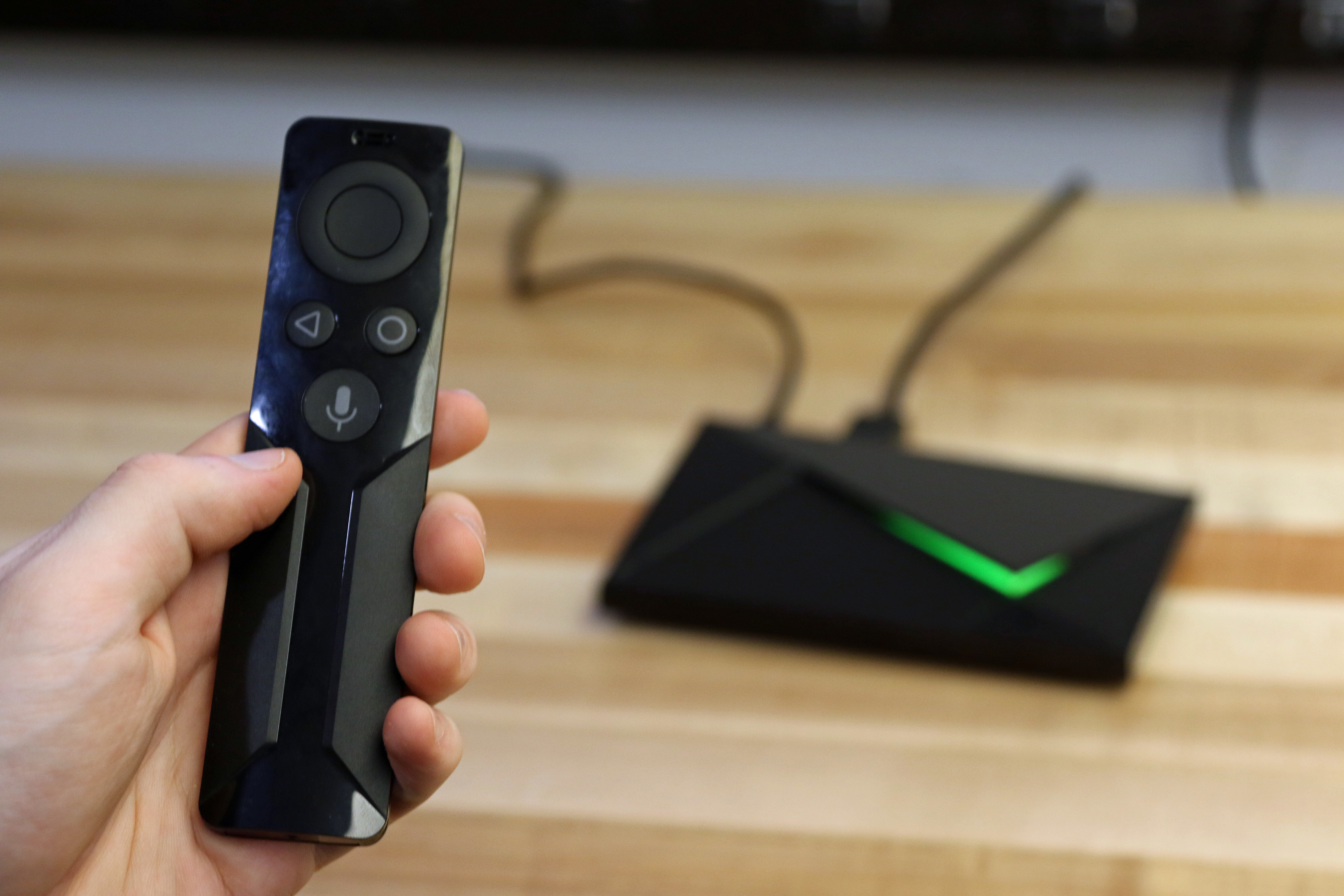
Enter the 2017 model of the Nvidia Shield ($200 with a 16GB hard drive; $300 with a 500GB hard drive). The system is smaller, sleeker, and packs more powerful hardware, but the real refinements are in the interface. The device now comes equipped with a unified gaming menu, built-in Google Assistant and even the Amazon Video app — a rarity among Android streaming systems.
MORE: Best Streaming Devices
Like the first Shield, the current model is still somewhat aspirational. While it will eventually be able to control smart home devices, for now it lacks that feature. The game selection is inconsistent, and the interface could be better. Still, the 2017 Shield represents a sizable improvement over its predecessor with a variety of video apps to watch and great-looking games to stream.
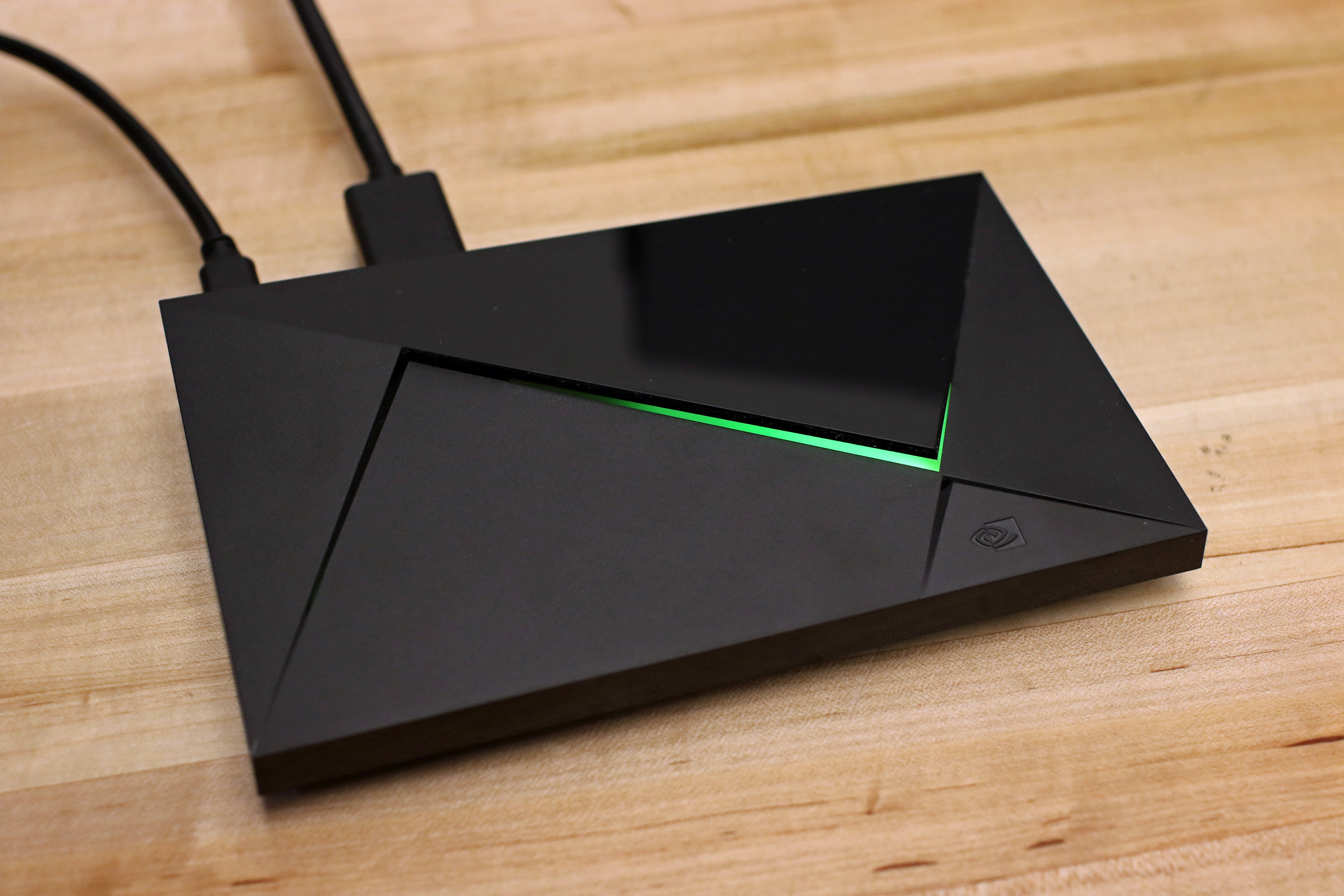
Design
The first thing I noticed about the Shield is that it’s tiny compared to its predecessor. At 6.3 x 3.8 inches, it still requires a lot more real estate than a Google Chromecast or an Amazon Fire TV, but considering that the old model was 8.3 x 5.1 inches, it’s a noticeable improvement.
On the other hand, the Shield retains its distinctive shape, which resembles a modern art sculpture, full of asymmetrical triangles and trapezoids. Its only adornment is a glowing green bar toward the center, which lets you know when the device is turned on. While it’s a bit showier than competing streaming boxes, I’d much rather have something that looks distinctive over yet another forgettable rectangle.
The Shield also has plenty of ports. In addition to spots for power and HDMI, you also get two USB ports and an Ethernet port at the expense of the microSD and microUSB ports from the previous version. While losing this functionality feels like a step backward, it’s not a disastrous one; you can still use USB storage in the two full-size ports.
By default, the Shield comes with 16GB storage, although you can pay an additional $100 for a full 500GB. Since you’ll be streaming most of your games and you can use removable USB storage, the upgrade isn’t strictly necessary, but 16GB still feels stingy for such an expensive device.
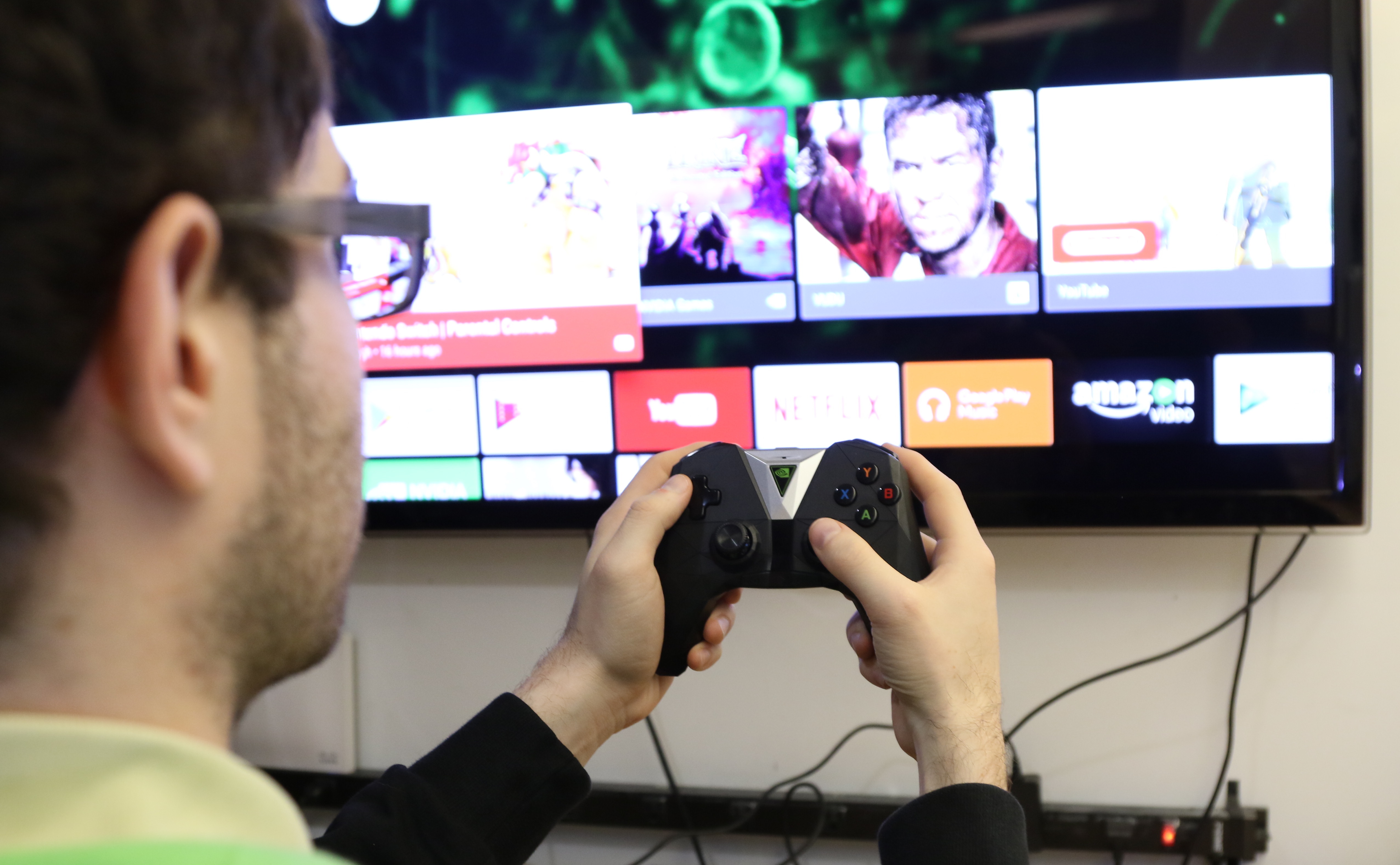
Gaming
Nvidia has been especially eager to highlight the Shield’s capacity for gaming. There are three ways to play, and they all work well. Users can download Android games, stream titles from Nvidia’s GeForce Now subscription program, or stream them on a local network through Steam. Using GeForce Now requires an $8-per-month subscription plan, and streaming through Steam requires a fairly powerful gaming PC. Of the three options, none is perfect, but each one is a far sight ahead of where it was last year.
One of the big problems with the original Shield was that it was never clear where to find the games you wanted to play. Android games, GeForce Now games and Steam games all lived in different menus, and navigating through them could be both time-consuming and confusing. Now, players can access all three from a unified menu simply called Nvidia Games. While buying new games can still be a complicated process (more on this shortly), finding the ones you already own is a cinch.
All three types of games work well, at least depending on your setup. I played the Android version of Final Fantasy IX, and was pleased to find that the game ran even smoother than when I experienced it on the original PlayStation as an angsty teen. From Borderlands: The Pre-Sequel to Star Wars: Knights of the Old Republic, native Android games are both gorgeous and seamless.
On the other hand, the Android selection is extremely inconsistent. For example, the Nvidia Games app highlighted a handful of Final Fantasy titles to celebrate the recent release of Final Fantasy XV, but I couldn’t find VII, Tactics, or Dimensions anywhere. Plenty of other beloved Android games, like Ridiculous Fishing or Monument Valley, are nowhere to be found. I asked Nvidia whether the Android selection would get better over time, but the company simply highlighted the existing hit titles, and discussed its plans to launch The Witness and Shadowgun Legends on the platform.
Side-loading games is an option, as the Shield allows users to install third-party applications — at their own risk, naturally. Still, downloading APKs from Google Play is a dicey proposition at the best of times, and downloading them elsewhere is just asking for trouble. If you’re looking for the best that Android has to offer, you may have to look elsewhere.
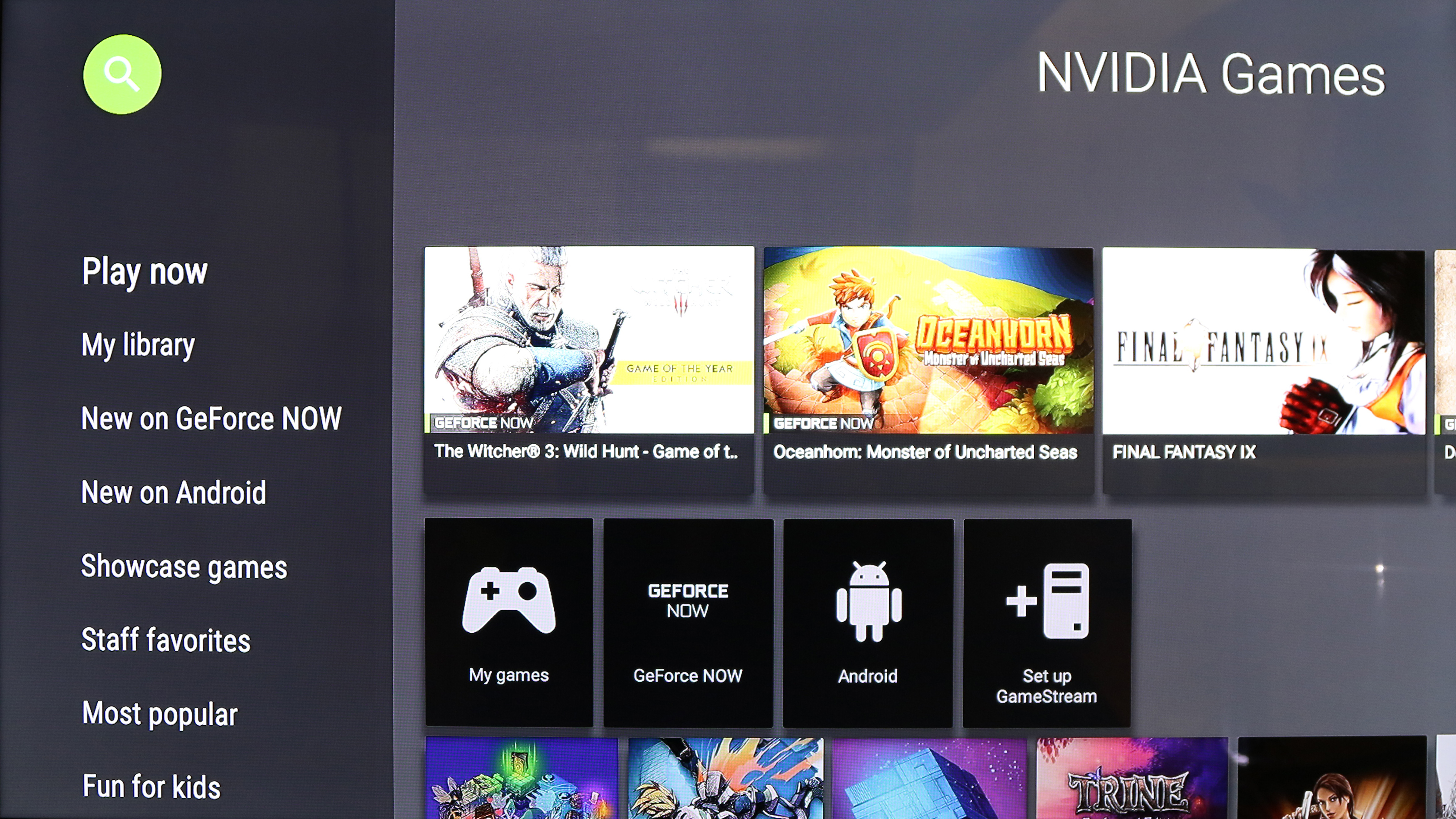
GeForce Now
GeForce Now is arguably the Shield’s biggest draw, and the service has grown considerably since last year. An $8-per-month subscription fee will net you a ton of excellent titles, including Ultra Street Fighter IV, the Tomb Raider reboot, Batman: Arkham City and Telltale’s The Walking Dead: Season 1. You can also buy games on top of that; these tend to be newer titles, such as The Witcher III: Wild Hunt, Abzu, Mad Max and Virginia.
As far as performance goes, GeForce Now is very good — or at least, it has the potential to be. When I turned off every other internet connection in the house (including on my phone) and plugged the Shield directly into my router, I finally achieved “optimal” streaming conditions, according to the device. (When I was downloading Steam games on my laptop, it was unusable; when my roommate was streaming Netflix in his bedroom, it was passable).
The games ran at full 1080p resolution at 60 frames per second, but I still ran into “high packet loss” conditions every few minutes or so, which resulted in screen tearing and lag. While these issues resolved themselves fairly quickly, it still made Batman’s confrontations with the Joker or Geralt of Rivia’s forays on horseback seem much less immersive. Even under ideal conditions — no other connected devices, an Nvidia-recommended router, download speeds in excess of what the Shield recommends — the experience isn’t perfect, and that’s disappointing. What’s encouraging, though, is that it’s almost there.
Streaming from a PC is also an extremely simple and effective process, provided you have a computer with a GeForce GTX 660 card or higher. Just open the GeForce Experience app on your PC and enable streaming. Compatible games (there are more than 100) will automatically show up in your Nvidia Games app on the Shield, and from there, you can play them just like any other title.
I streamed The Witcher III from a Razer Blade Pro laptop plugged into my router, and the experience was totally seamless. Not only did I get full 4K resolution and framerates between 30 and 60 fps, but there was never any slowdown, tearing or freezing. To really tax the Shield, I played Dark Souls III at max settings as well. In a Souls game, one false move will kill you, and I’m pleased to report that each stroke of my sword and each dodge from a deadly enemy attack happened instantaneously.
The downside to streaming games from a PC, of course, is that you need to have a fairly powerful PC already on hand, and it helps if you can use an Ethernet cable rather than Wi-Fi. Furthermore, if all you want is a way to get Steam games in your living room, a Steam Link is a much cheaper solution. But streaming top-of-the-line PC games would be unthinkable for streaming devices like the Roku Ultra or Apple TV, so the Shield deserves credit for doing something that no other streaming box can.
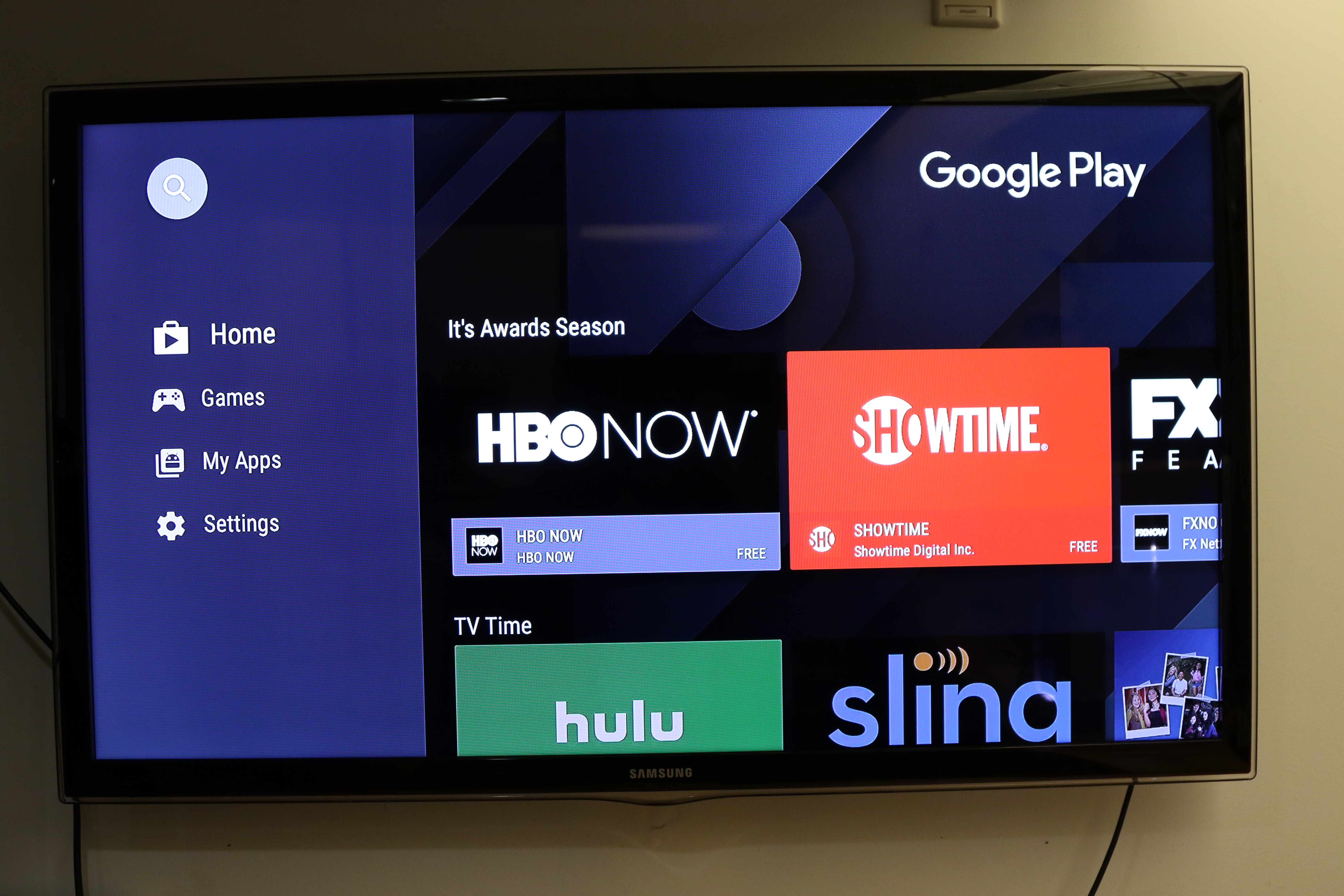
Apps
Since the Nvidia Shield is a full-fledged streaming media player, how well it handles games is only half the picture. Users will also want to stream movies, TV shows and music. Not only does the Shield possess the best app streaming app selection of any Android TV device, but it can play videos in full 4K HDR as well.
If you’ve used another Android TV device before, you won’t be surprised to learn that the Shield has access to all the usual suspects: Netflix, YouTube, Hulu, Vudu, Plex and Pandora, among others. (I didn’t see Spotify, although the app is available for the previous Nvidia Shield, so it’s probably on its way.) However, the Shield has one app that no other Android TV gadget possesses: Amazon Video.
Through an exclusive deal with Amazon, Nvidia was able to circumvent the longstanding feud between Amazon and Google, and bring one of the most popular streaming video apps to the Shield. Unlike Netflix, Amazon doesn’t charge any additional money for 4K and HDR programming, making it an easy way to showcase some of the Shield’s best features. Including this app is an absolute triumph, and Nvidia deserves kudos for going out of its way for giving viewers what they want.
Beyond that, you can download apps like VLC or MX Media Player to view your own side-loaded content, as well as a handful of productivity, networking and social media apps. The Android TV selection is still pretty small, compared to what you’d get on a Roku or Apple TV, but whether I wanted to watch videos, listen to music, sort through files or even host my own media server, I had plenty of options.
It’s also worth noting that the Shield has Google Cast features. Whatever a Chromecast can do, the Shield can do as well. For the most part, this isn’t necessary, since it’s just as easy to use the controller to navigate to Netflix or Hulu. Still, Chromecast has a ton of niche apps that aren’t available on Android TV, so it’s a helpful feature that worked well in all of my tests.
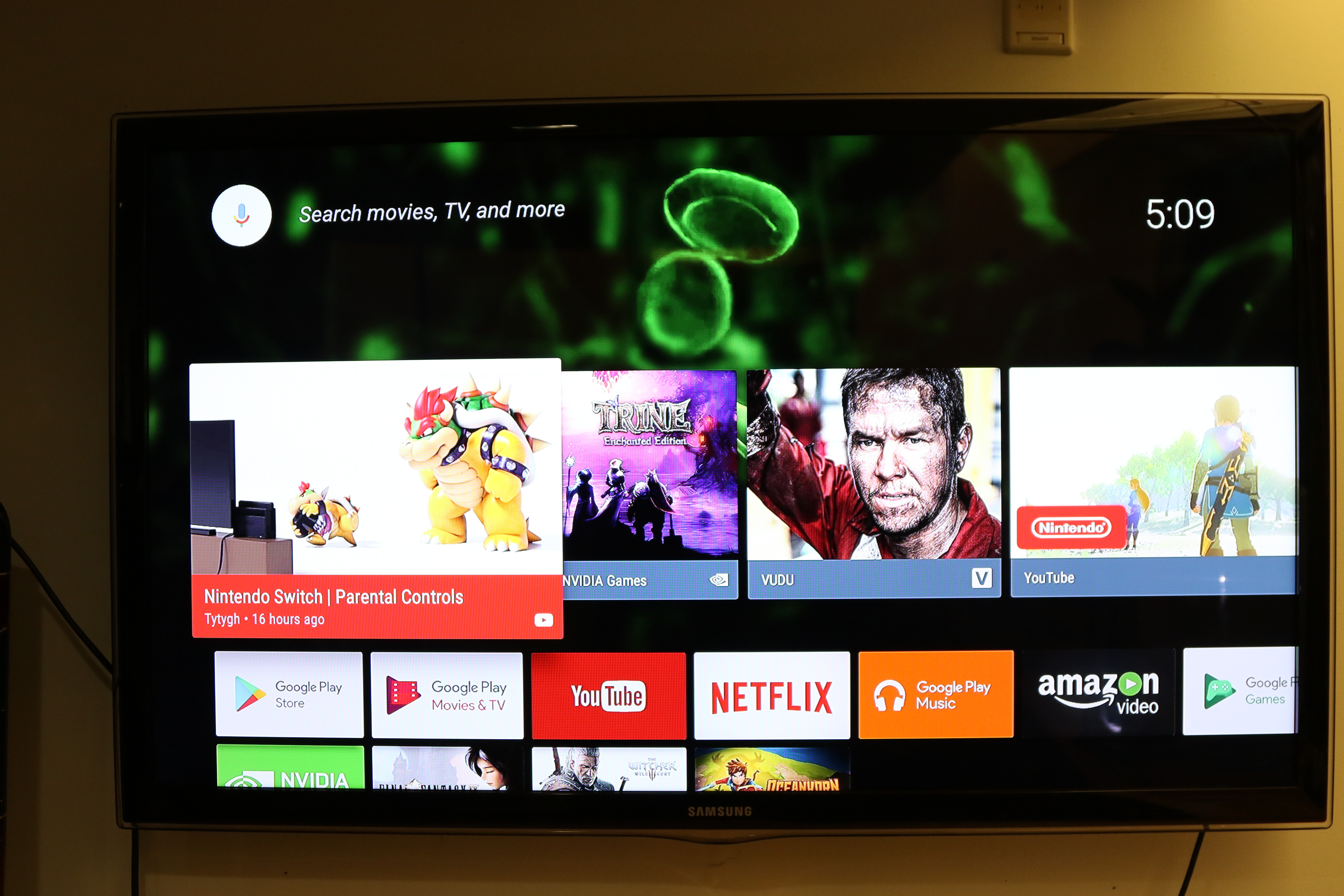
Interface
Android TV has improved over the last few years, but it’s still the black sheep of the streaming media player category. It doesn’t have that many apps, as discussed previously, but it’s also not very well organized. Rather than letting users customize their own home screens, Android TV puts a handful of algorithmic recommendations from YouTube and Google Play up top, followed by apps, games, and settings below that. It’s all sensible enough, but it feels haphazard.
Finding new apps in the Google Play store can also be something of a problem. While you can do a voice or text search if you know exactly what you’re looking for, browsing is a bit of a mess. Rather than offering you categories right up front (Video Apps, Role-Playing Games, etc.), it displays rows upon rows of curated content, saving the categories until the very end.
MORE: How to Buy a Streaming Media Player
Worse still, the categories sometimes don’t include content that’s already been highlighted in the curated sections. It’s never clear how many apps are available in a given category, and users have no ability to sort them by popularity, price or upload date.
At least the universal search feature for streaming content is pretty good. If you perform a voice or text search for a given TV show or movie, the Shield will provide results from a variety of different apps, including Netflix, Hulu, YouTube and the Google Play Store. This makes it easy to not only find what you want to watch, but to compare prices for it as well.
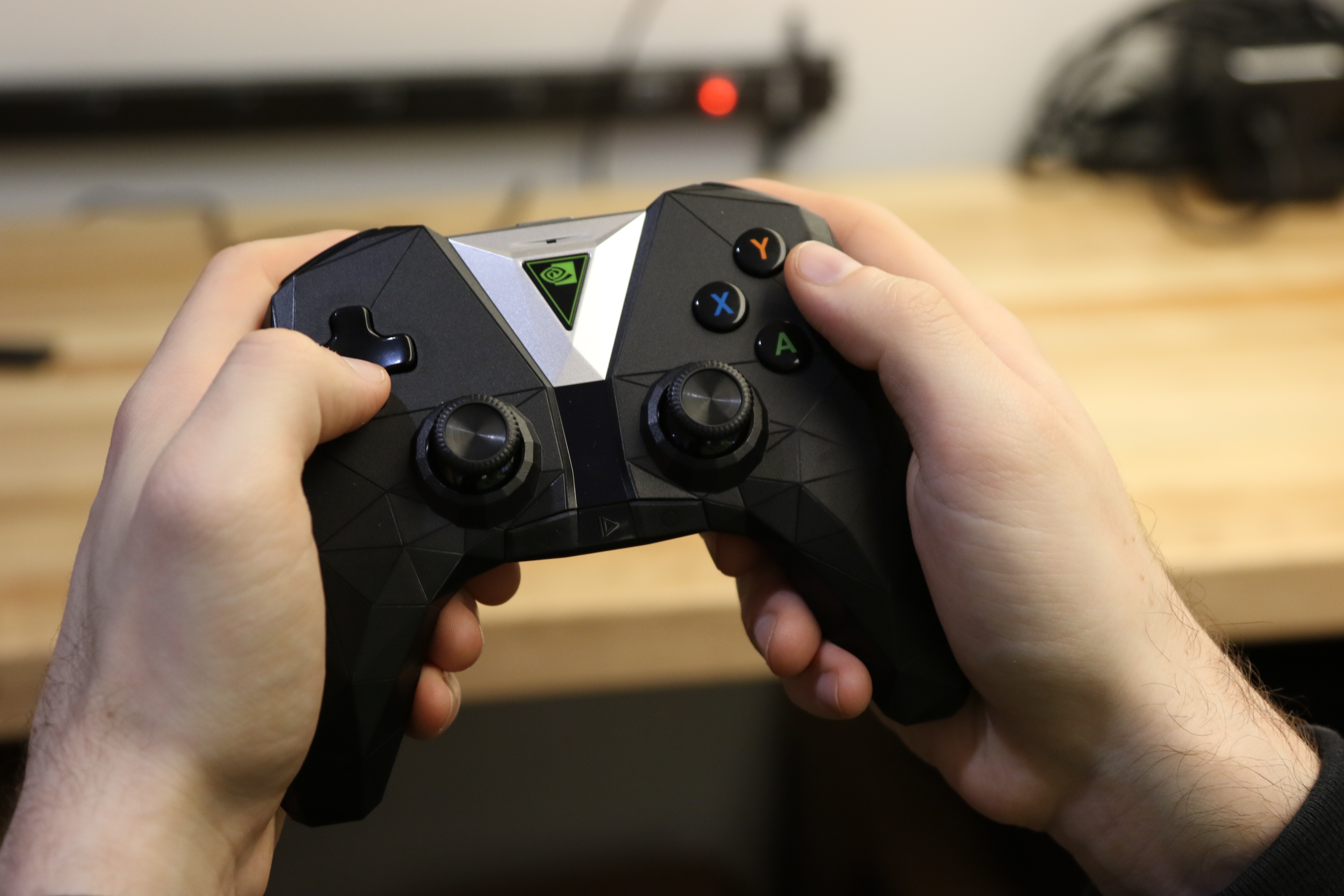
Peripherals
While you can use just about any Bluetooth peripheral with the Nvidia Shield, the player has two specialized peripherals: a game controller and a remote control. In my original Shield review, I pointed out that the remote control was too insubstantial to warrant selling it as a separate accessory. Nvidia seems to have taken the criticism to heart, as the new Shield comes with both peripherals.
The remote control is a competent accessory, but not a very exciting one. It’s a small black rectangle with a control wheel, a confirm button, a back button, a home button, and a mic button to activate voice search. Users can slide their thumbs up and down the center to control the volume. My only criticism is that it’s powered by two watch batteries rather than a rechargeable lithium ion unit. If you run out of juice late at night, you’re going to have to wait until the drugstores reopen before you can use it again.
The controller, on the other hand, is a thing of beauty. Slightly smaller and much more angular than the original Shield controller, the new peripheral is comfortable to hold and extremely intuitive to use. With two control sticks, a directional pad, four face buttons and four shoulder buttons, it looks and feels a lot like a traditional gamepad. On the other hand, it also has a volume slider, similar to the remote, as well as back, pause, and home buttons. Users can also tap the Nvidia symbol in the center to open up a voice search with a built-in mic.
Nvidia claims that its rechargeable battery can last for 60 hours at a time; we didn’t have time to test this claim empirically, but using it for a whole day of gaming didn’t seem to put much of a dent in its charge. Unfortunately, there’s no easy way to tell when the controller is charged, or when it’s low on battery; the only way to monitor battery life is to boot up the Shield and look in the accessories menu. A charging light would not have gone amiss.
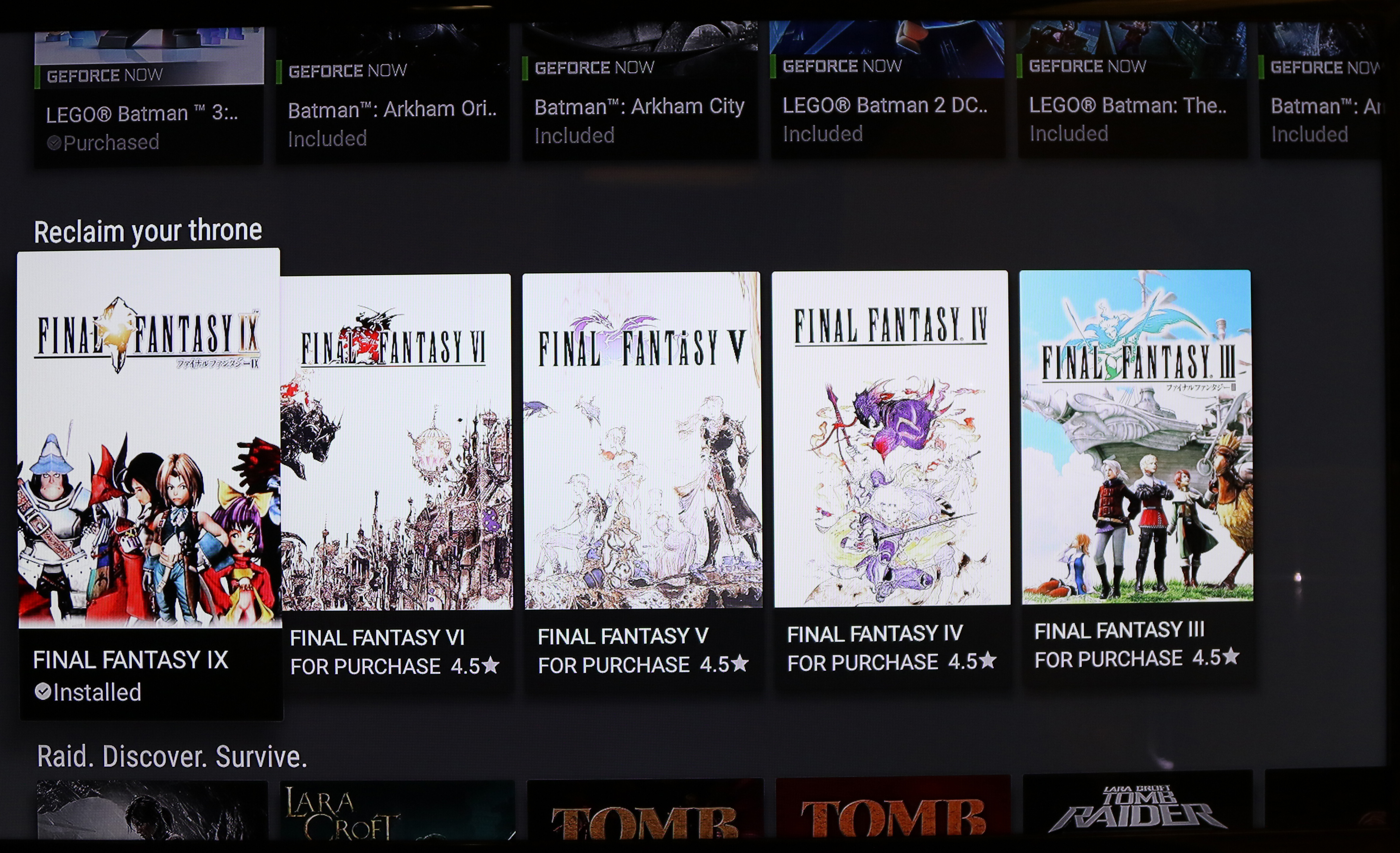
Google Assistant Inside
The Shield does has Google Assistant built in, albeit in a fairly limited form. You can ask it for a weather or traffic report, or to find nearby restaurants, and it will provide pictorial info. You can also use Google Assistant to hunt down TV shows, movies or photos for you. The functionality is OK; when I asked it to "play Stranger Things," it showed me a bunch of YouTube clips of the show. When I just searched "Stranger Things," it brought me to a full landing page, complete with a link to Netflix. Obviously, there are still a few kinks to be worked out. On the other hand, I asked it to find me pictures of golden retrievers, and I was not disappointed with the pages upon pages of adorable dogs that followed.
Nvidia Spot
Eventually, you'll be able to use the Shield to control smart home functionality through a program known as Nvidia
Spot. By communicating with Google Assistant, users will be able to give verbal commands to their thermostats, lights, alarms and more. Some devices will work through Wi-Fi; others will require the use of a USB dongle. Users will also be able to program their morning and evening routines. Saying "start my day," for example, could turn on the lights, boot up a coffee maker and show you the traffic conditions on your way to work.
Using the Shield as the central hub for your whole house, however, isn’t possible at the moment. Given how much Nvidia hyped this feature when it first announced the Shield, it’s disappointing to learn that the functionality is so far away.
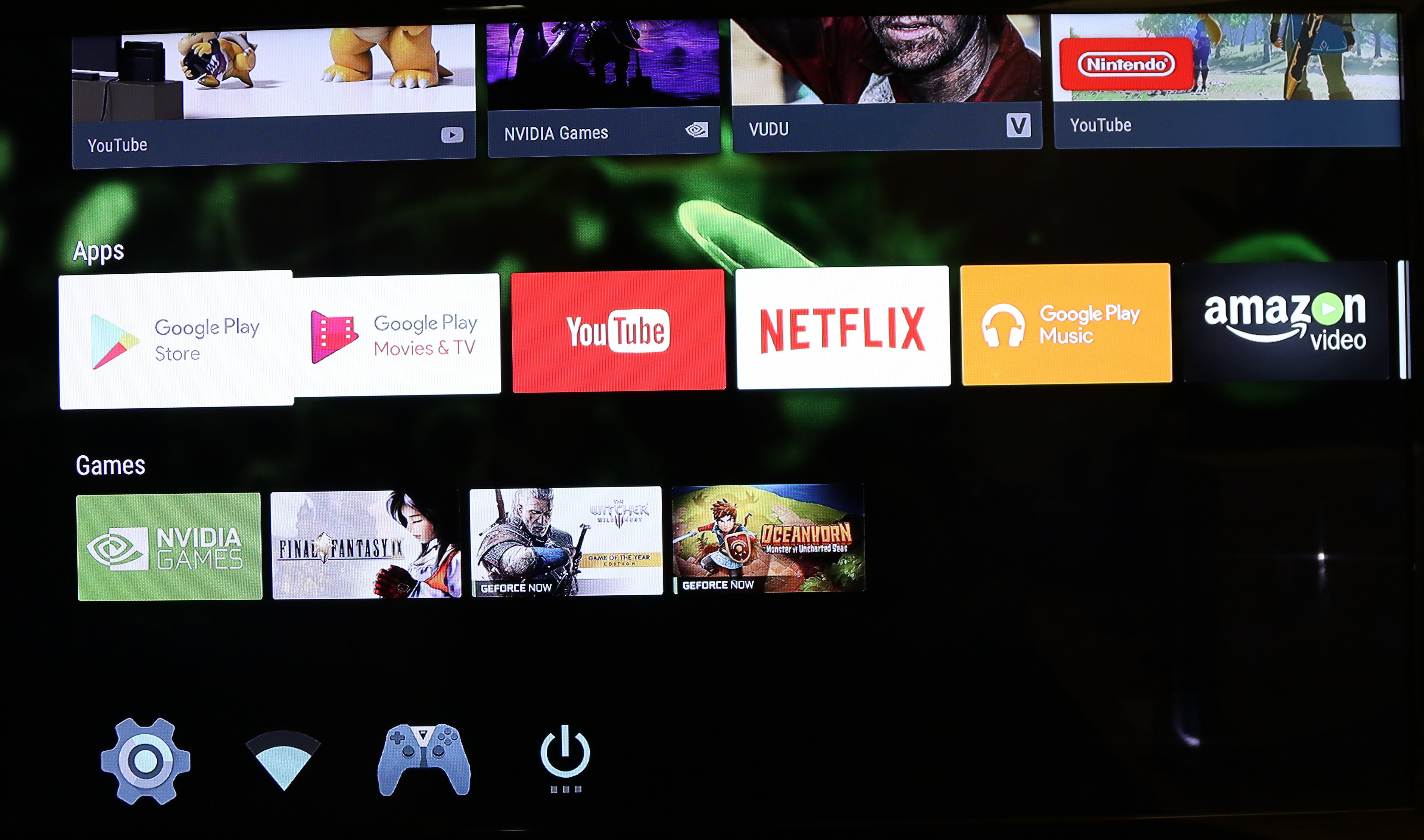
Bottom Line
In theory, the new Nvidia Shield sounded revolutionary: a one-stop shop for streaming, gaming and total control over your home. In practice, it’s almost there. You can almost play the best games on Android. You can almost stream GeForce Now games seamlessly. You can almost use Google Assistant to control your home.
Still, falling just short of greatness isn’t a problem, given Nvidia’s track record of keeping its promises. As is, the Shield offers fantastic video apps (including Amazon), a refined GeForce Now experience and plenty of ways to enjoy your existing movies, music and games. While it’s a bit pricier than other streaming boxes, it also offers a lot more. Not everyone will need an Nvidia Shield, but those who want a hybrid game console/streaming box may find that it fills a very comfortable niche.
Marshall Honorof is a senior editor for Tom's Guide, overseeing the site's coverage of gaming hardware and software. He comes from a science writing background, having studied paleomammalogy, biological anthropology, and the history of science and technology. After hours, you can find him practicing taekwondo or doing deep dives on classic sci-fi.

